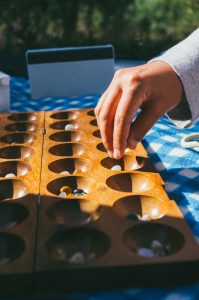SOCIAL AND CULTURAL

Congkak
With a population of just over 50,000, Kangar is the smallest of the nation’s state capitals and was granted municipal status in 1980. The state’s population stands at over 250,000 today. For the year 2000 the state’s ethnic composition was: Malay (174,805 or 79.74%), Chinese (21,058 or 9.6%), Indian (2,658 or 1.21%) and others (20,690 or 9.45%).
The census in 2010 had the religious composition as: 87.9% Muslim, 10.0% Buddhist, 0.8% Hindu, 0.6% Christian, 0.2% Taoist or Chinese religion followers, 0.2% non-religious, 0.2% unknown / none, and 0.1% followers of other religions.
Although a small minority, the state’s Thai population stands out as unlike other states where the British colonial influence is more pronounced, the major external influence in Perlis has come from its Thai historical connection. Thai culture is reflected in the local architecture, food, arts and crafts, language and lifestyle of the local population.
Both Malaysian and Thai border communities have family relationships that transcend the colonial and post colonial boundaries. Thai culture is still very noticeable in the architecture, local cuisine, the people’s relaxed attitude to life, and even the language as most locals speak some Thai.
People who live along the border are said to often ignore the immigration hassle by walking across to visit family members on the other side. In Kangar itself, the Malay dominant multi ethnic and multi religious composition moulded by the most recent period of colonial rule is reflected in the town’s character and activities.
Downtown Kangar has been described as a mixture of old and new shophouses, with an elegant colonial State Secretariat Building and a prominent clock tower from the 1930s. Both the structures are examples of consistent and enduring colonial building monuments found in the main urban centers of the country.